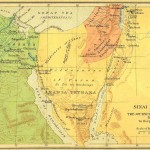Reliving the experience – Mass’ei
 At times the Torah is a history book, at times an atlas. This Shabbat it is both. It details the route of the Children of Israel through the wilderness, listing the stopping places like a travelogue.
At times the Torah is a history book, at times an atlas. This Shabbat it is both. It details the route of the Children of Israel through the wilderness, listing the stopping places like a travelogue.
Rashi asks the obvious question, “Why are these stations recorded here?” – in other words, “What religious teaching can there be in an itinerary?”
The answer he suggests is that it shows the kindness of the Almighty, who, though often angry with the people, ensured they had places to rest as they went through the desert.
The Rambam also says the itinerary teaches a religious lesson. “Miracles,” he says, “are only convincing to those that witnessed them; coming generations, who know them at second hand, may consider them figments of the imagination… Now the greatest of all miracles in the Torah is the stay of the Israelites in the wilderness for 40 years with a daily supply of manna.”
Is the Rambam not hinting here at the fact that the greatest miracles are the small daily ones?
The fact that the people had food to eat as they traversed difficult territory is, when you think about, truly amazing. The doubters would certainly have said it was impossible and decided that other things in the Torah must have been equally impossible. But listing the stopping places ensures the credibility of the story.
And when any of us looks back over their own life, with all its highs and lows, its failures as well as its successes, we too ought to be amazed and grateful to the Almighty for the little miracles that kept us going, for the times – often, thank God, very lengthy – when we had m’nuchah, and above all for the quiet courage, faith and determination that kept us going regardless.



